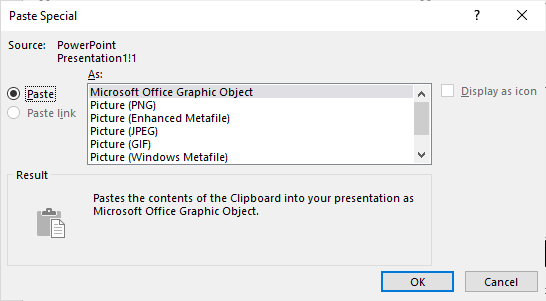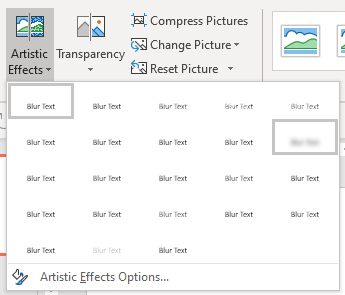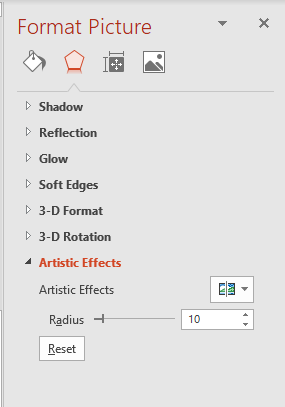Blur Text on a PowerPoint Slide to Create Interesting Effects
by Avantix Learning Team | Updated September 7, 2023
Applies to: Microsoft® PowerPoint® 2013, 2016, 2019, 2021 and 365 (Windows)
Blur is an artistic effect that you can apply to a picture in PowerPoint. However, artistic effects cannot be applied to text boxes or text placeholders. If you want to blur text in PowerPoint, you'll need to cut the text object and then paste it back into PowerPoint as a picture. You will then be able to blur the text.
You can create some interesting effects if you combine animation with blur such as making clear text changing to blurred text and vice versa.
Recommended article: How to Match Colors in PowerPoint Using the Eyedropper
Do you want to learn more about PowerPoint? Check out our virtual classroom or live classroom PowerPoint courses >
Note: Some Ribbon tabs may appear with slightly different names if you are working on Office 365 and have a smaller screen or different display settings.
Apply a blur effect to text
To apply a blur effect to a text object:
- In Normal View, select the text object by clicking its edge.
- Press Ctrl + X to cut it. You can also press Ctrl + C to copy it.
- Click on the slide and then click Paste on the Home tab in the Ribbon. A drop-down menu appears.
- Select Paste Special. A dialog box appears.
- Select PNG and click OK or press Enter. PNG has a transparent background so it's usually the best choice. You cannot apply blur to some of these image formats.
- Click the picture.
- Click the Picture Tools Format or Picture Format tab in the Ribbon and select Artistic Effects in the Adjust group. A drop-down menu appears.
- Select Blur (the last option in the second row).
You may still need to delete the original placeholder.
Select PNG in the Paste Special dialog box (although you can use other formats, PNG has a transparent background):
Blur appears in the Artistic Effects drop-down menu:
Adjust the blur
You can adjust the blur applied to a picture using the Format Picture task pane:
- Right-click the blurred image and select Format Picture. A task pane appears.
- Click the Effects button at the top of the task pane.
- Click the arrow beside Artistic Effects to expand it.
- Drag the slider line beside Radius to increase the blur.
Below is the Format Picture task pane:
You can achieve some interesting effects with blur with different types of images.
Subscribe to get more articles like this one
Did you find this article helpful? If you would like to receive new articles, join our email list.
More resources
How to Blur an Image in PowerPoint
Troubleshoot Slide Numbers in PowerPoint Decks
How to Get Slide Design Ideas Using PowerPoint Designer
How to Remove the Background of a Picture in PowerPoint (2 Ways)
Where to Find Free Images for Your PowerPoint Presentations (10 Great Stock Photo Sites)
Recommended courses
Microsoft PowerPoint: Intermediate / Advanced
Microsoft PowerPoint: Design for Non-Designers
Microsoft PowerPoint: Animations Bootcamp
Our instructor-led courses are delivered in virtual classroom format or at our downtown Toronto location at 18 King Street East, Suite 1400, Toronto, Ontario, Canada (some in-person classroom courses may also be delivered at an alternate downtown Toronto location). Contact us at info@avantixlearning.ca if you'd like to arrange custom instructor-led virtual classroom or onsite training on a date that's convenient for you.
Copyright 2024 Avantix® Learning
You may also like
How to Replace Zeros (0) with Blanks in Excel
There are several strategies to replace zero values (0) with blanks in Excel. If you want to replace zero values in cells with blanks, you can use the Replace command or write a formula to return blanks. However, if you simply want to display blanks instead of zeros, you have two formatting options – create a custom number format or a conditional format.
What is Power Query in Excel?
Power Query in Excel is a powerful data transformation tool that allows you to import data from many different sources and then extract, clean, and transform the data. You will then be able to load the data into Excel or Power BI and perform further data analysis. With Power Query (also known as Get & Transform), you can set up a query once and then refresh it when new data is added. Power Query can import and clean millions of rows of data.
How to Freeze Rows in Excel (One or Multiple Rows)
You can freeze one or more rows in an Excel worksheet using the Freeze Panes command. If you freeze rows containing headings, the headings will appear when you scroll down. You can freeze columns as well so when you scroll to the right columns will be frozen.
Microsoft, the Microsoft logo, Microsoft Office and related Microsoft applications and logos are registered trademarks of Microsoft Corporation in Canada, US and other countries. All other trademarks are the property of the registered owners.
Avantix Learning |18 King Street East, Suite 1400, Toronto, Ontario, Canada M5C 1C4 | Contact us at info@avantixlearning.ca










